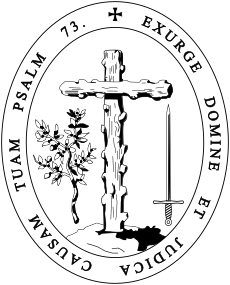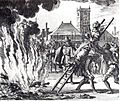Spanish Inquisition facts for kids
Quick facts for kids Tribunal of the Holy Office of the Inquisition in SpainTribunal del Santo Oficio de la Inquisición Spanish Inquisition |
|
|---|---|

Seal for the Tribunal in Spain
|
|
| Type | |
| Type |
Tribunal under the election of the Spanish monarchy, for upholding religious orthodoxy in their realm
|
| History | |
| Established | 1 November 1478 |
| Disbanded | 15 July 1834 |
| Seats | Consisted of a Grand Inquisitor, who headed the Council of the Supreme and General Inquisition, made up of six members. Under it were up to 21 tribunals in the empire. |
| Elections | |
| Grand Inquisitor and Suprema designated by the crown | |
| Meeting place | |
| Spanish Empire | |
| Footnotes | |
| See also: Medieval Inquisition Portuguese Inquisition Mexican Inquisition |
|
The Spanish Inquisition was a special court that started in Spain in 1478. It was created by King Ferdinand II of Aragon and Queen Isabella I of Castile. They had help from a religious leader named Tomás de Torquemada. The Spanish Inquisition was known for its very strict methods. It helped the Spanish kings and queens gain more power over their newly united country.
The rulers of Spain asked the Pope to create this court. Their main goal was to find people who claimed to be Christian but were secretly practicing other religions. In 1492, all Jewish people were ordered to leave Spain. Many left, but some stayed and said they were Christians. The Inquisition then worked to decide who was telling the truth. In 1502, Muslims were also ordered to leave. When Protestants appeared later, the Inquisition also investigated them. Most trials ended with the person giving up their old beliefs and being set free.
The Inquisition became less active over time. It was finally ended completely in 1834.
Contents
The Spanish Inquisition: What Was It?
The Spanish Inquisition was a powerful religious court. It was set up in Spain during the late 1400s. Its main job was to make sure everyone in Spain followed the Catholic Christian faith. It was a very important part of Spanish history for over 300 years.
Why Was the Inquisition Started?
Spain's rulers, King Ferdinand and Queen Isabella, wanted a strong, united country. They believed that having one religion, Catholicism, would help achieve this. They were worried about people who had converted to Christianity but might still be practicing their old religions in secret.
- Finding Secret Believers: The main reason was to find Jewish people who had converted to Christianity but were thought to be secretly practicing Judaism.
- Forcing Unity: Later, Muslims were also ordered to leave Spain or convert. The Inquisition then looked for those who might be secretly practicing Islam.
- Stopping New Ideas: When Protestant ideas spread in Europe, the Inquisition also tried to stop them in Spain.
How Did the Inquisition Work?
The Inquisition had a system of courts and judges. It was led by a person called the Grand Inquisitor. This leader was in charge of the Council of the Supreme and General Inquisition. This council had six members. Under them, there were up to 21 local courts across the Spanish Empire.
- Investigations: The Inquisition would investigate people accused of not being true Christians.
- Trials: People would face trials where they had to explain their beliefs.
- Punishments: Punishments varied. Many people were made to confess and change their ways. Some faced very harsh treatment. Public ceremonies called auto-da-fé were sometimes held.
The End of the Inquisition
Over the centuries, the power of the Spanish Inquisition slowly decreased. People started to question its methods and its purpose. By the early 1800s, its influence was much weaker. The Spanish Inquisition was officially ended on July 15, 1834. This marked the end of a long and often difficult period in Spanish history.
Images for kids
-
Bartolomé Esteban Murillo. The martyrdom of San Pedro de Arbués (1664).
-
The burning of a 16th-century Dutch Anabaptist, Anneken Hendriks, who was charged with heresy
-
Auto-da-fé, Plaza Mayor in Lima, Viceroyalty of Peru, 17th century
-
Diego Mateo López Zapata in his cell before his trial by the Inquisition Court of Cuenca
-
The Inquisition Tribunal as illustrated by Francisco de Goya
-
Rizi's 1683 painting of the 1680 auto-da-fé, Plaza Mayor in Madrid
-
Auto-da-fé, Viceroyalty of New Spain, 18th century
-
The Peruvian Inquisition, based in Lima, ended in 1820
-
Contemporary illustration of the auto-da-fé of Valladolid, in which fourteen Protestants were burned at the stake for their faith, on 21 May 1559
-
Monty Python members Terry Gilliam, Michael Palin and Terry Jones performing "The Spanish Inquisition" sketch during the 2014 Python reunion.
See also
 In Spanish: Inquisición española para niños
In Spanish: Inquisición española para niños













